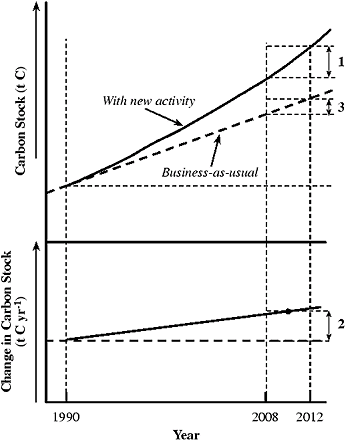|
4.6.3. Reference Year, "Additionality," and Baseline Issues
Reference in Article 3.4 to "changes in greenhouse gas emissions.and removals"
imply that credit will be based on a comparison between two points in time or
two paths through time. There are several ways this comparison might be done,
and the Protocol itself prescribes three alternatives in different places. Any
one of the alternatives might be adapted (or slightly modified) for activities
under Article 3.4. The choice will have significant implications for the amount
of credits available and the data required for accounting. The choice could
also affect accounting of the interaction of activities undertaken under Article
3.3 and Article 3.4 and the consistency of national and project accounting (see
Chapter 5). These three possibilities-all of which may
pose problems in implementation-are discussed in the following sections and
illustrated in Figure 4-12.

|
|
Figure 4-12: Three possibilities for evaluating
change in carbon stocks attributable to Article 3.4 activities. Figure
shows total carbon stock (above) and annual change (below) for an activity
that causes an increase in carbon stocks and the path that would have
been followed without the activity. The activity is arbitrarily assumed
to have begun in 1990. The example chosen shows an increase in carbon
stocks with respect to business-as-usual, but the principles are equally
relevant if the activity resulted in a decrease in carbon stocks with
respect to business-as-usual. If the stock in 2008 is taken as the reference
(Section 4.6.3.2), the credit for the first commitment
period will be as shown by arrow 1. If the change in carbon stocks in
1990 is taken as the reference (Section 4.6.3.1),
the credit will be as shown by arrow 2. If the business-as-usual scenario
is taken as a baseline (Section 4.6.3.3), the
credit will be as shown by arrow 1 minus arrow 3.
|
|